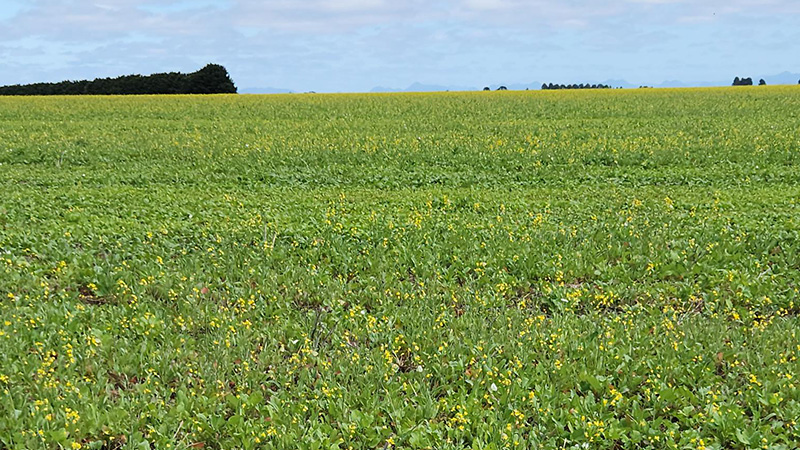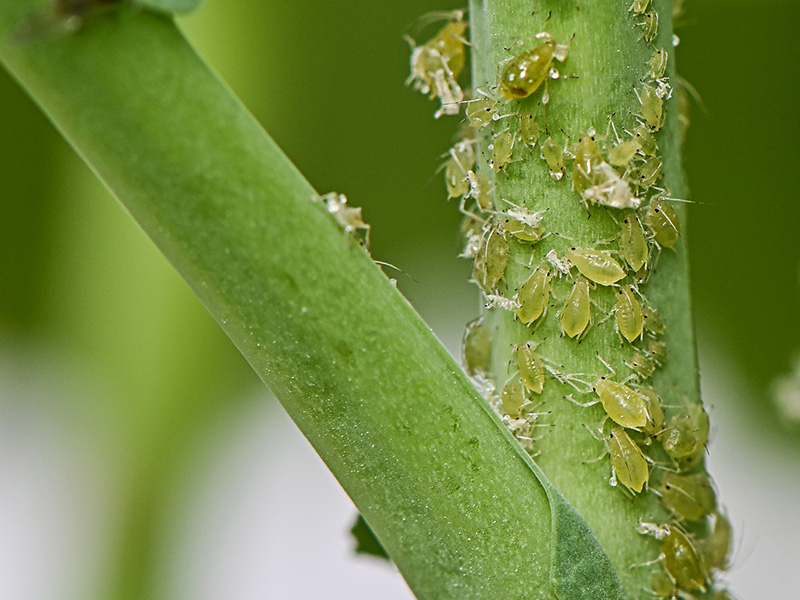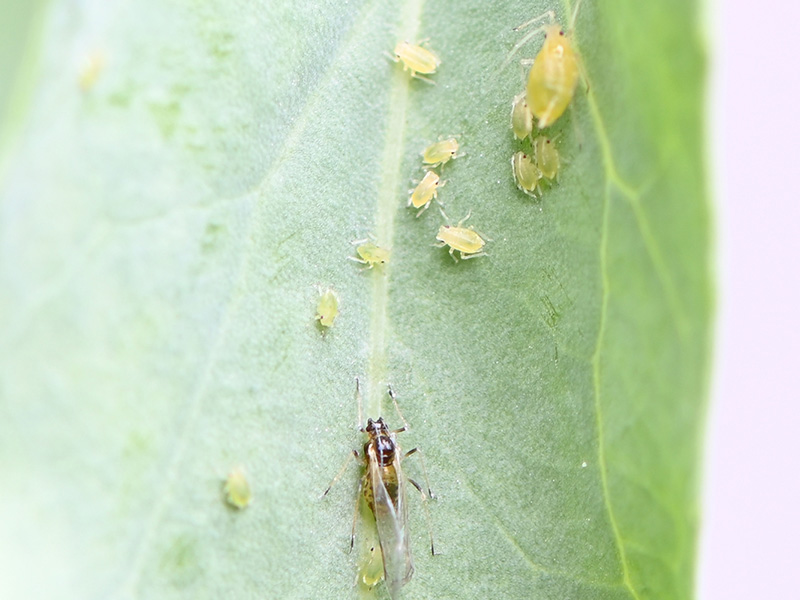Paddock Practices: Manage green bridge to reduce virus/aphid risk in canola
Paddock Practices: Manage green bridge to reduce virus/aphid risk in canola
Date: 14 Mar 2024

Key points
- Moist summer conditions have supported strong volunteer crop growth, which may encourage high green peach aphid numbers this season.
- Eliminate green bridge volunteers at least two weeks before sowing winter crops, especially canola.
- Apply an insecticide seed treatment to canola and budget for an early foliar spray.
- Monitor crops for aphids using fenceline sticky traps and regular crop inspections.
- Apply foliar insecticide soon after aphids are detected, to stop them spreading throughout the crop.
Grain growers are urged to eliminate green bridge growth (volunteer crop or weed growth) now to mitigate the threat of aphid-borne viruses such as turnip yellows virus (TuYV) in the coming growing season.
Volunteer canola is currently widespread across much of the southern region and warm conditions appear to already be favouring aphid persistence. A TuYV outbreak could cause significant damage to canola crops.
Recent field surveillance and virus testing by Agriculture Victoria and supplied to GRDC has confirmed aphid infestation and a high incidence of TuYV infection in these green bridge volunteers, warranting a proactive response.
Along with controlling the green bridge where possible, growers are strongly encouraged to apply an insecticide seed treatment this year and should budget for and consider an early foliar insecticide application.

Summer conditions set up a repeat of 2014
A relatively moist summer has set up similar conditions to those that produced a significant outbreak of TuYV in canola during 2014.
In that season an abundance of volunteer canola became infested with green peach aphid (Myzus persicae), which is the main vector for TuYV. The result was significant infection and damage in that year’s crop, with the most severe impact on seedlings that had not received an insecticide seed treatment.
The virus-stunted seedling growth resulted in many growers destroying their crop and planting barley over it to gain a viable harvest. The remaining canola crops generally recovered and grew to maturity but suffered significant yield losses.
Very warm conditions and adequate soil moisture over the 2023-24 summer has resulted in widespread self-sown canola that is already flowering in many locations.
These plants will survive beyond this season’s sowing window and are likely to provide a good breeding habitat for green peach aphids and TuYV.
The virus can also infect several other broadleaf crops, including chickpeas, lentils, field peas and forage brassicas, while cereal crops may be at risk from other aphid-borne yellow dwarf viruses.
Eliminating green bridge is essential
Green bridge volunteers can provide a carry-over habitat for other pests and fungal pathogens. They therefore add significant pest and disease pressure to crops early in the season, increasing the risk of losses and/or the need for added pesticide and fungicide applications.
Spraying volunteer crops and weeds, especially those growing in close proximity to crop paddocks (for example on fencelines and headlands), is highly recommended. These green bridge plants should be eliminated at least two weeks before sowing the new season’s crop. Removing them even earlier generally reduces pests and diseases in and around the paddock.
Growers should also consider spraying, grazing or mowing untilled areas near the crop, especially those located into the prevailing wind, so they will not support persistence and movement of aphids.

Monitoring will enable early detection
Proactive monitoring and early detection of aphid infestation supports effective control. Sticky traps deployed along fencelines, particularly on upwind fences, can provide effective early warning of aphid flights into the crop.
Once in the crop, green peach aphid can be small and difficult to spot. They often colonise large areas of the crop without producing substantial colonies on individual plants, making them both hard to find and potent virus vectors. The recommended method is to hold a light-coloured tray or sheet of paper under the plant and then knock the leaves sharply to dislodge the insects.
Regular and frequent checks of the crop are essential. If aphids are detected, then inspection further into the paddock can help establish the scale of the infestation.
The presence of green peach aphids does not necessarily mean TuYV is also present, and the aphids rarely cause economically important damage through feeding alone.
However, TuYV infection prior to flowering can cause significant yield and seed quality damage. If aphids are detected, plant samples should be collected and sent for TuYV testing. Victorian growers can send plant samples for disease testing to Agriculture Victoria – Crops Health Services, while South Australian growers can use the SARDI crop diagnostics service.
Should aphid numbers continue to build up prior to flowering, a second round of testing may be warranted. Once the crop has begun to flower, canola will tolerate TuYV infection and foliar insecticides are no longer warranted.
If the virus is detected at relatively low levels, the entire paddock should be sprayed as soon as possible. If no virus is detected and aphids continue to build up prior to flowering, a follow-up test is recommended.
Control green peach aphids to reduce TuYV risk
Green peach aphid is exceedingly difficult to control and populations in Australia have demonstrated resistance to over 70 insecticides including carbamates, organophosphates and synthetic pyrethroids.
They have also exhibited reduced sensitivity to neonicotinoids and this may be impacting the effectiveness of these insecticides under field conditions. However, neonicotinoid seed treatments are still considered to provide emergent canola protection from green peach aphid and subsequently reduce or slow down TuYV spread.
Foliar insecticides with an active ingredient from the sulfoximine class of chemicals (Group 4C, i.e. Transform® (sulfoxaflor)) proved most effective in the 2014 outbreak. These should be applied as soon as aphids are detected, to prevent them spreading TuYV throughout the crop.
Newly registered compounds such as afidopyropen (Versys®) and flonicamid (MainMan®) are also likely to be effective for TuYV control if applied and timed correctly.
However, foliar insecticides will have no impact on TuYV-associated yield losses once a widespread infection has occurred.
Sowing canola into standing cereal stubble has been shown to reduce aphid landing rates, while later sowing may mean the crop emerges after early-season aphid flights. However, sowing too late may expose pre-flowering canola crops to TuYV infection from aphid flights that occur in late-winter and spring, when temperatures begin to increase.
GRDC is also developing an investment which may deliver new options for future green peach aphid control.

About green peach aphid and TuYV
- Green peach aphid is a sap-sucking insect that is the main vector for TuYV. It is also a vector for several other viruses, including cucumber mosaic virus, cauliflower mosaic virus and turnip mosaic virus.
The aphid survives on green broadleaf hosts as well as very young seedlings. In the right conditions, aphids can move from green bridge to crop hosts very rapidly. They can travel up to four kilometres per day, with migration being supported by wind direction and host availability.
Generally, with aphids entering a crop from nearby host plants or with the prevailing wind, they will colonise the outer parts of the paddock first.
- Turnip yellows virus (TuYV) is an economically important virus that can infect a wide range of broadleaf crops and weeds. The main vector is the green peach aphid.
Possible symptoms include yellow, red or purple leaf discoloration, leaf deformation and curl. Early infection also causes canola plants to develop much more slowly or stop growing altogether, leading to significant yield losses or total crop failure. However, TuYV infection may also produce less visible symptoms, such as reductions in the number of pods, seeds per pod and number of branches, that still cause significant yield losses.
The magnitude of yield and seed quality losses is likely to depend on the variety sown, time of infection, virus strain present, temperature, humidity, and the presence of other biotic and abiotic stressors.
Post-flowering infection is less likely to affect oil yield in winter-sown canola, but other crops such as chickpeas may still be impacted.
This GRDC Paddock Practices was produced in collaboration with AgCommunicators, the Western Australian Department of Primary Industries and Regional Development (DPIRD), Macquarie University, Agriculture Victoria and Marcroft Grains Pathology.
Useful resources
- GRDC Podcast: Managing green peach aphids and the emerging turnip yellows virus risk in canola (Mar 2024)
- GRDC Update Paper: Insecticidal control of green peach aphid and turnip yellows virus – resistance threats, limitations and future alternatives (Feb 2023)
- GRDC Video: Managing green peach aphid and turnip yellows virus (Feb 2021)
- GRDC Fact Sheet: Green bridge (Jul 2020)
Contacts
Ben Congdon
WA Department of Primary Industries and Regional Development
benjamin.congdon@dpird.wa.gov.au
08 9368 3499
GRDC Project Code: DAW2305-003RTX,
